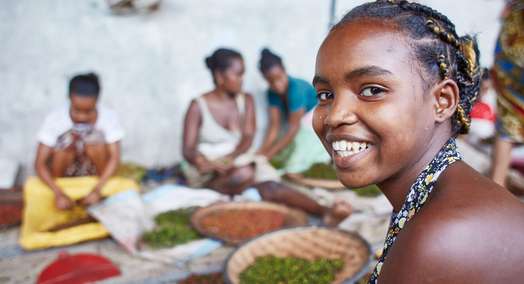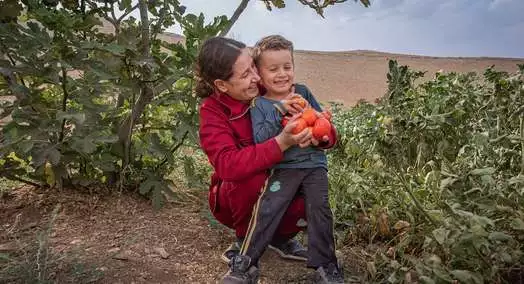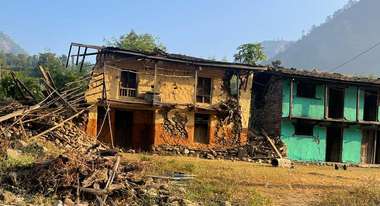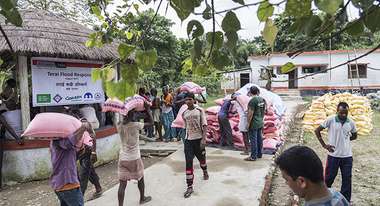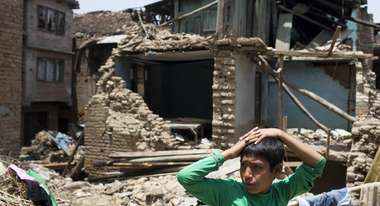Heartbreak, Resilience, Hospitality
After a devastating earthquake hit Nepal, Francesca Schraffl visited the people in small and remote villages of the country. Many of them lost their loved ones; houses and possesions are destroyed. Welthungerhilfe supports Nepal with emergency aid.
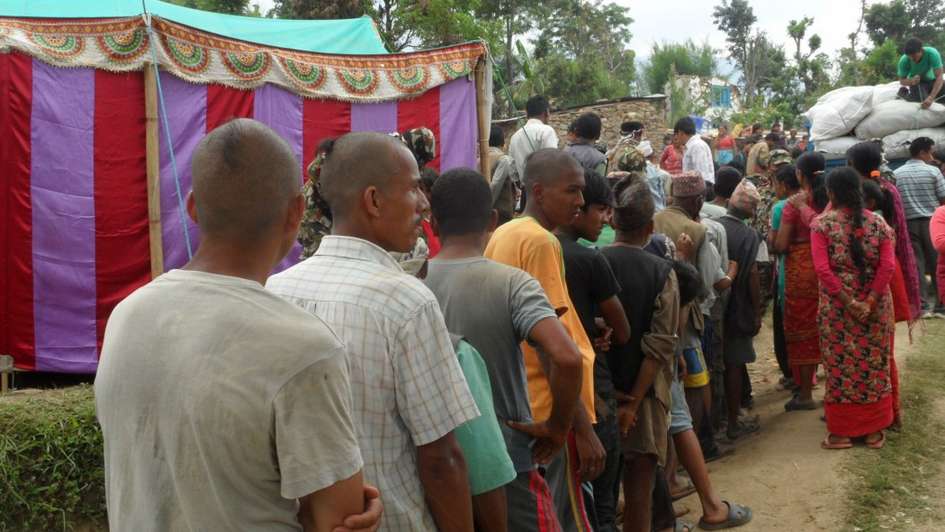
A shaved head with just a small turf of hair at the back. According to Hindu tradition, this is what the males do, when a family member dies. These shaved heads are what accompanied me, for the three days I spent in the mountains, distributing tarpaulins (tarps as we call them) and blankets to remote villages. Every time I saw one, I felt something gripping my heart. Is that small boy now without a mother, a sibling? Did that man lose his older brother, father, or a child?
I knew, from reading the daily UN reports circulated among the relief community, how devastating the earthquake had been in Sindhupalchowk district, how many casualties there had been, how many houses had been completely flattened to the ground. So I thought I was prepared, I knew what I was going to find. But I wasn’t. I was not prepared to see the destruction that surrounded our car, as we slowly climbed the steep and rocky roads. One heap of debris after the other, nothing else. One door still latched, one window still open; one upside down chair, one table with a book on it; one single shoe, one random item of clothing. These are some of the things that remained intact, standing there, in the middle of nothing, as a stark reminder of what was, and now isn’t anymore.
Terrible road conditions and many devastated villages
I wasn’t prepared for the stench that came from underneath these debris, a sign that someone (but maybe it was ‘just’ a pet, I told myself) had not made it out of the house in time. I wasn’t prepared to see a Search and Rescue team in action, trying to recover a body from a pile of bricks, the rest of the family standing around and waiting. And I certainly was not ready to hear the story of the 4-year old who, in Gunsa – the most remote village we visited – had been dug out by the army the day before. Dead. She wouldn’t be, the Lieutenant told me, if they or a rescue team had reached the village before – she was still alive, when she got trapped in her own house. But the Nepali army got there only few days ago, slowed down by terrible road conditions and by the need to provide support to the many other devastated villages they found on the way; to reach Gunsa, they had to walk four hours, the equipment on their backs. No, I wasn’t prepared for any of this. And it’ll take me a while to process it all.
A long-awaited demand of blankets and tarpaulins
I also wasn’t prepared for the old Nepali man that, in our first village, asked me if we had brought shelter. He obviously didn’t speak English, and my broken Hindi did not help me understand his Nepali dialect, but he used his hands, and drew a tent above his head. “Yes” I almost shouted “yes, we have brought it!” and I drew a tent in the air too. I wasn’t prepared to see children playing happily table-tennis, in the courtyard of a collapsed school, or hide-and-seek among the pile of bricks of what was left of a building. I wasn’t prepared to be fed, together with the other seven members of the team, by Nepali families, who were so grateful to us for having brought them tarps that they used the temporary fire-place they had built under a shaky wooden shed, to offer us a full dinner, with rice, vegetables, dal (lentils) and even roasted chillies! I was not prepared to have a khata (traditional ceremonial Buddhist scarf) put around my neck by a Nepali woman, to be officially thanked by the only villager who spoke English, on behalf of the rest of them, and to receive a round of applause. All of this, because we brought them tarps.
This is just a fraction of what I have experienced in these three days on the field. Together with our partner Rural Reconstruction Nepal (RRN), we had set off to distribute blankets and the long-awaited tarpaulins, to some of the most remote areas in the Sindupalchowk district.
Finding our way to remote villages: It took us five hours to cover 90km
The trip was itself an adventure: it took us five hours to cover 90 km, and another three to drive the last 15 km. Once in Melamchi, the hub where an army camp has been set up and from which the Chief District Officer decides what goes to which village, according to needs and availability, we had to look for smaller trucks, because the ones we had were too big to make it all the way to the villages we had been allocated. On the way, we were stopped by a group of villagers who had put big rocks across the road to stop passing trucks, asking for some material to be given to them too. “We did not get enough!” pleaded one of the villagers. “We are going to those who got nothing,” was the unquestionable response of Dr. Sarba Khadka, Advisor to RRN and Coordinator of the Right to Food Network. We had to wait while the driver removed the bigger stones from the road, so that we could drive through. We had to get off our car to push a pick-up who got stuck in the middle of a creek. We had to unload one truck and go back few kilometres to recover the load of the second one, which had broken down on the way. We made it to the villages only late at night, and set up our tents in the dark, waking up to collapsed buildings and broken houses, but also to the breath-taking beauty of this country, with fields of such a brilliant green you just want to lie down in them, endless seas of wheat sheaves moving in the wind and – of course – there, majestic as one would imagine, the snowy peaks of the Himalayas.
We distributed tarps in three areas consisting of several villages; people lined up in front of the desk, waiting for their turn to sign or, very often, put their inked thumb on a piece of paper, to confirm they received the material. Old men, walking with a stick; hunched women, slowly putting one foot after the other; young children whose parents were sick, or old, or disabled, and could not come to collect the material themselves. They all left with a smile on their face – sometimes even posing for a picture! – some walking as far as 5 kms away, on steep paths, carrying the tarp and the blanket on their backs, supported by a scarf they tied around their head, the same way they carry bundles of grass or baskets full of wood. The tarp could now be used to shelter themselves and their food, either supported by some wooden poles or, for the luckier ones, as a roof for temporary sheds they managed to build with the existing material. They can also be used as ‘plastic walls’ of improvised latrines, to give back to families, especially women, some privacy and thus some dignity. After more than ten days spent at the mercy of the whims of the weather this will be their only way of protection until their houses are re-built, shielding them also from the upcoming monsoon rains.
In Gunsa, the one where the 4-year old died and where we were given the ceremonial scarves, we met a medical team from Germany, the Bergwacht Sachsen. They were the first people to arrive in that area after the earthquake, last Saturday, even before the army. The community had been completely on their own for a week, by the time they reached. One of the team members told me, while looking at the men and women dressed in their traditional tamang clothes walking away satisfied with the bundle on their heads: “You made a whole village happy today. We normally do not stop working until it gets dark, there’s a line of people waiting outside our tent. Since when you came with the tarps, nobody showed up!“
„This clearly shows how much more important tarps are, even than their own health”.
I can’t stop thinking about that little girl, how lonely and scared she must have felt, waiting for someone to come and save her. I can’t stop picturing her family, hearing her cry and trying to frantically remove the bricks with their hands, not managing to reach her. Nothing will replace the loss they, and many others like them, have gone through. But I like to think that the tarps and blankets we brought will provide at least some physical comfort to them, allowing them to mourn their little girl, without having to worry about the rains about to come.
